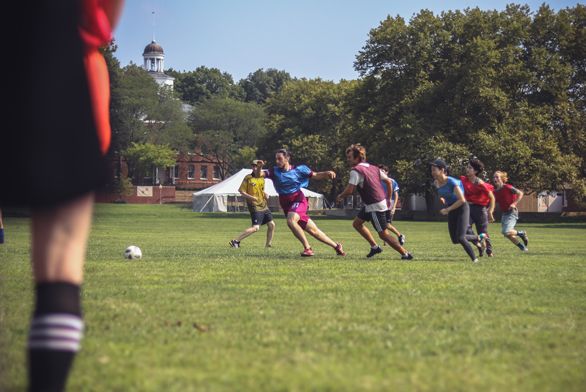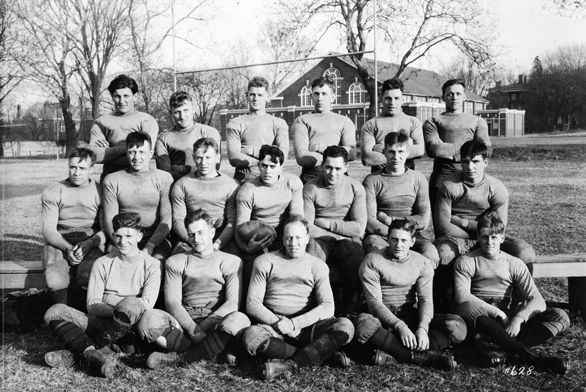“The Sweatiest Liberal Art:” Annapolis Intramural Program Celebrates 60 Years
January 14, 2022 | By Les Poling

In 1938, only one year after transforming the entire academic model of St. John’s College, president and cofounder of the New Program Stringfellow Barr announced another revolutionary change in a letter to the St. John’s Collegian newspaper: the abandonment of intercollegiate athletic competition for “a greatly expanded and exclusively intramural athletic season.”
At the time, Barr’s proclamation sent shockwaves through the college community. Up to 1938, St. John’s—until 1937 a military school—had regularly fielded teams, particularly in football and lacrosse, that were regional powerhouses and a source of genuine pride for many Johnnies. In the early 1930s, the St. John’s lacrosse team performed so well that it was chosen to represent the United States in international competition; the football team was renowned in the mid-Atlantic for its intense rivalry with nearby Johns Hopkins. Many alumni, especially, protested that forsaking intercollegiate play would hurt school spirit—and, perhaps, school finances.
And yet, Barr stood firm in his decision, writing: “When the St. John’s Program was inaugurated in September of last year, nobody expected it to find the proper support from the semi-professionalized system of intercollegiate athletics which American colleges have developed in recent years. The policy of the college requires the subordination of extracurricular activity to the main educational purposes.”
It took a few decades for intramurals to fully engage the St. John’s student population, in one part due to the disruption of WWII, in another the growing pains of recruiting and retaining students unfamiliar with or initially indifferent to intramural competition. But in 1962, legendary St. John’s Athletic Director Bryce Jacobsen (Class of 1942) began the final leg of Barr’s revolution, scrapping the system of organizing intramural teams by seminar in favor of something new: a group of fixed teams led by captains, with their own colors, sophomore drafts, and players who remained on their team for all four years at the college (and beyond).
With that, the St. John’s intramural program was born. And in this year, its 60th season, athletics at the college are as thrilling as ever.
Six Decades of Competition
According to Athletic Director Chris Krueger (A07), the intramural program of today closely resembles the system devised by Jacobsen in 1962.
“People sometimes come to campus to play, and they graduated in the ‘70s or ‘80s,” Krueger says.
There are some differences. For much of the intramural program’s existence, there were divided men’s and women’s teams: the Panzas, Reds, Greenwaves, Guardians, and Spartans on the men’s side, and the Maenads, Amazons, Furies, and Nymphs for female students. These days, students of all sexes and gender identities compete together as members of the Druids, Hustlers (replacing the Panzas and Reds), Guardians, Greenwaves, and Spartans, with Kunai offering another avenue of competition for female and non-cisgendered students (Johnnies can and do compete in both Kunai and the intramural program).

There have also been tweaks and gradual evolutions in the sports played, the points system, participation numbers, and more throughout the decades. Johnnies have invented new sports for the intramural program (reasonball, for one); there have been minor changes in the style and number of blazers awarded at the end of each year. But the general structure has remained the same, and so has the operating ethos that defines athletics at the college—and leads Krueger to call St. John’s intramural program the “greatest in the country.”
“What makes this program the best or greatest athletic program in the country is that everyone’s an athlete, and we earnestly want everyone to participate,” he says. “With every decision we make, the question is: What will this do for participation?”
Furthermore, Krueger explains, the intramural program is not separate from the rest of the college. The games students play—whether as Druids, Hustlers, and the like or as part of Kunai—aren’t intended to function as a distraction from the rigor of the Program. The competition, and even the teams themselves, serve as a complement to the ideas and texts discussed around the seminar table.
“I think what’s allowed the intramural program to persist and, frankly, to thrive over all these years is that it gives people a place to explore deeply—and in real time, in a microcosm—who they are, what the world is, and where the world and their agency intersects,” Krueger muses. “It allows them to explore ideas from the academic Program in a venue that is less significant and important than the seminar, tutorial, or lab, but still feels intensely significant and often terribly important. And the teams provide a stable platform for the explorations that individuals undertake; they allow us to hold together while also being distinct.”
“Athletics are not independent, not wholly independent anyway, from the academic Program,” he continues. “In fact, the two intersect in all these interesting, subtle ways, because of how deeply this community cares about the work they do at the college. Whether in jokes or spirited exhortations, hardly ever does a game go by without a Program reference popping up. The way people think about sports here is distinct because it is informed by the way people think—and often can’t stop thinking—about the main work of the college: the academic Program.”
It’s likely for that reason that the St. John’s intramural program has maintained an impressively high rate of participation—often greater than 50 percent—among the student body. This year, coming off nearly a year and a half without full in-person competition, the trend is holding strong. Krueger can’t be 100 percent sure, but if the trajectory from fall 2021 continues into the spring, then this academic year may have the college’s highest numbers of intramural participation ever. Importantly, he notes, that isn’t a sea change resulting from a year without competition; while pent-up energy certainly plays a role, the enormous enthusiasm is a “continuation of a steady climb.”
To explain that phenomenon, Krueger returns to the uniqueness of athletics at St. John’s.
“A piece of what makes our program special is that we want to be careful and deliberate about what we do, so that we don’t separate the community but instead bring it together in the most shared experience that we can,” he says.
From netball with Kunai in Temple Iglehart to intramural soccer on the back campus, the Johnnies of 2022 can testify to the power of that aim as much as the Class of 1962. Here’s to another 60 years of athletics at St. John’s!
Selected Intramural Records and Achievements: 1962–2021
This data—included in the forthcoming book The Sweatiest Liberal Art, a collection of lectures, letters, and essays about athletics at St. John’s—was compiled from the plaques in Iglehart Hall. The work was initially undertaken by Jon Barone (A13), Greenwave captain, in 2012.
Championship Tallies:
- The Hustlers have won the most overall championships: H–17.5, W–13, G–12, S–8.5, D–8
- The Hustlers have won the most soccer titles: H–16, W–14, D–12, G–10, S–6
- The Guardians have won the most football/reasonball titles: G–17, H–14, W–11, D–10, S–5
- The Hustlers have won the most basketball titles: H–16, G–14, W–11, S–10, D–7
- The Hustlers have won the most handball titles: H–9, W–7, D–4, G–4, S–3
- The Spartans have won the most ultimate frisbee titles: S–4, W–3, G–2, H–2, D–1
- The Druids have won the most softball titles: D–12, H–9, G–5, W–4, S–2
- The Druids have won the most volleyball titles: D–12, W–10, H–9, G–7, S–6
Miscellaneous Statistics:
- The Hustlers are the only team who have swept every sport, and they’ve done it twice (1970 and 2001).
- The Hustlers have won the most championships in a row (four, and tied for a fifth).
- The Greenwaves have won 13 overall championships, including nine of the last 20 seasons (2002–2021). In this period, the Greenwaves had two three-peats.
- The Guardians are the rulers of football/reasonball, having won 17 out of the 56 possible titles,
- including a four-year streak (2005–2008) and a five-year streak (1973–1977).
- The Spartans won a handball title when it was originally instituted in 1990, but the sport did not make a return until 1995, and the Spartans did not win a handball season again until 2019.
- The Guardians won a soccer title in 1988 but then did not win soccer again until 2016–2017, a 28-year drought.
- Softball was reinstituted as an intramural sport for one season in 2016. The Spartans won the title.
- For two years (1995–1996), indoor soccer was an intramural sport. The Greenwaves and the Hustlers each one once.
- The Spartans have not won a football/reasonball title since 1989.
- In 1989, there was an intramural swim meet.
- For several years in the 1980s, there were individual team competitions in fitness. In the 1980s, there was also an intramural track meet.
- The only tie for an overall championship was in 1976, between the Spartans and the Hustlers.

